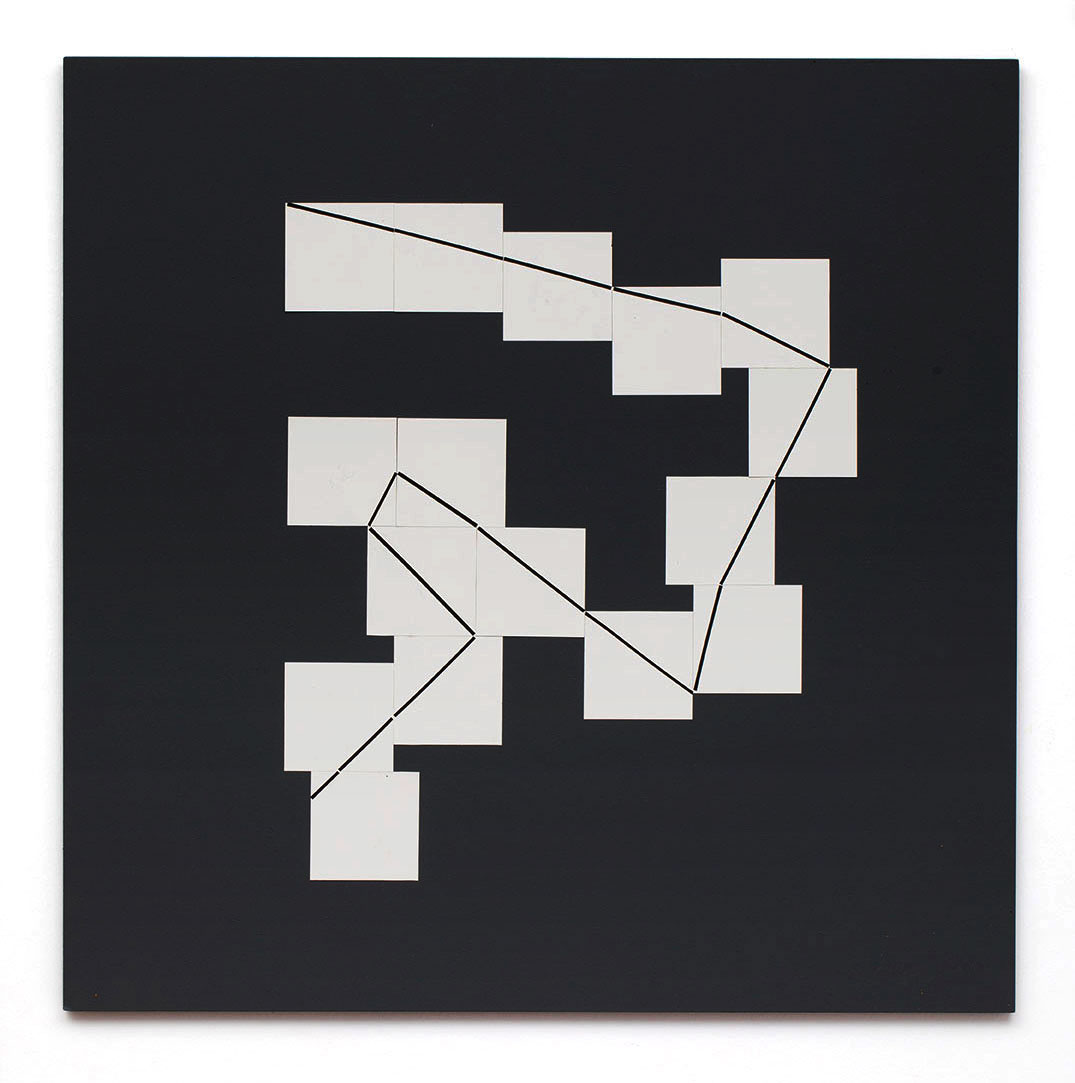Építészmérnökként végzett a budapesti Műszaki Egyetemen, majd tervezési gyakorlatot szerzett. 1956 és 1959 között tanársegédként dolgozott a bécsi Műegyetem Építészeti Tanszékén, ahol az építészeti és művészeti formaalkotás közös gyökereiről tartott előadásokat. 1963-tól képzőművészként tevékenykedett, mellette egy bécsi építészeti irodában dolgozott. Első önálló kiállítását 1964-ben rendezte az osztrák fővárosban. Művészeti aktivitása az egyéni és csoportos tárlatokon való részvételeken túl, kiterjedt számos nemzetközi és hazai kiállítás szervezésére, párizsi, hollandiai, osztrák és szlovén művészeti csoportok tevékenységében való aktív részvételre, a magyar konstruktív, konkrét és konceptuális művészet nemzetközi színtéren való megismertetésére és amint hazatérhetett, feleségével, Maurer Dórával együtt a szabad művészeti információáramlás megteremtésében és megőrzésében. 2006-ban közösen döntöttek a Nyílt Struktúrák Művészeti Egyesületet megalapításáról, melynek hazai és nemzetközi tárlatain rendszeresen részt vett. Két munkájával jelenleg az Innováció a kortárs képzőművészetben című, Vasarely Múzeumban rendezett nemzetközi kiállításon szerepel.
Gáyor Tibort a kezdetektől az egzakt kifejezés érdekelte. Alapos technikai és nyelvi kísérletek, anyagkutatás, a grafika mint médium analitikus vizsgálata, valamint rövid koncept art alkotói korszak után, élete végéig konstruktív-konkrét művészként tevékenykedett. A rajz, akvarell és sokszorosító grafika művelése mellett főleg kollázs technikájú képeket, reliefeket, objekteket és installációs műveket alkotott.
1970-ben, majd 1972-től véglegesen a tektonikus hajtásstruktúrák módszeres kutatásával foglalkozott. Műveit AMPHIGRAMMÁknak, tiszta plasztikai állításoknak nevezte, melyekben egyetlen alapproblémát vizsgált szisztematikusan, újabb és újabb jelentésréteget teremtve és feltárva: a négyzetbe tömörített tér lehetséges formáit, struktúráit, belső erőviszonyait, mozgását, szétbontással, kihajtással, hajtogatással járó változásának formai, esztétikai és jelentésbeli következményeit.
Gáyor Tibor szenvedélyes kíváncsisággal és rendkívüli koncentráltsággal követte végig a szabályos négyzet – ritkábban téglalap, később egyenlő oldalú háromszög – mértani és matematikai arányú deformálásával, vagy arányosan csökkenő soraik irányváltó mozgásával – a síkból a térbe, majd a síkba való visszatéréssel keletkező, tér-idő kapcsolatokat generáló strukturális változásokat. Művei a primer látvány élményéből indultak ki, és az analitikus folyamatok után ugyanide tértek vissza. Bár soha nem akart mást mutatni és mondani, mint ami a kiinduláskori és a létrejött rend maga, szeriális és kombinatorikus, szigorú geometrikus művészete a szándékolt mozgás spirituális rítusát idézi, rend-képeinek matematikai-logikai tisztasága mágikus erőt sugároz.
Gáyor Tibor interdiszciplináris gondolkodású, a különböző jelenségek – természet, művészet, tudomány, társadalom és élet közötti összefüggéseket közös rendszerbe illesztő és műveibe egészként integráló, erősen intellektuális és rendkívül innovatív alkotó volt. Tisztelettel, szeretettel gondolunk rá, sokat tanultunk tőle.
In Rememberance of Tibor Gáyor (1929-2023)
Tibor Gáyor graduated with a degree in architecture from the Budapest University of Technology and then acquired practical training in design. From 1956 to 1959, he worked as a teaching assistant in the Department of Architecture at the Vienna University of Technology, where he gave lectures on the common roots of visual language and form in architecture and art. He held his first solo exhibition in the Austrian capital in 1964. In addition to his participation in solo and group shows, his artistic activities also entailed organising numerous international and national exhibitions. On top of actively participating in several art groups in Paris, Austria, Slovenia and the Netherlands, he was also an avid promoter of Hungarian constructive, concrete and conceptual art on the international scene. As soon as he was able to return to his home country, together with this wife Dóra Maurer, he worked to establish and preserve the free flow of information in art. In 2006, Gáyor and Maurer decided to jointly found the Open Structures Art Society. The OSAS regularly held national and international exhibitions, in which Tibor Gáyor frequently showcased his works. Two of his pieces are included in the international exhibition Innovation in Contemporary Art, currently on view at the Vasarely Museum.
From the very beginning, Tibor Gáyor was interested in exact expression. After his thorough experiments in techniques and language, his in-depth research into materials, his analytical examination of graphic art as a medium, and his brief period of creating conceptual art, he came into his own as a constructive-concrete artist and continued along that path until the end of his life. In addition to drawing, watercolour and printmaking, he mainly created collages, reliefs, objects and installation works.
He began to systemically research the tectonics of folded structures in 1970, to which he then devoted himself completely as of 1972. He referred to his works as AMPHIGRAMS. He conceived of them as pure plastic statements, in which he systematically investigated a single basic problem, creating and exploring new layers of meaning: the possible forms, structures, internal power dynamics and movements of space condensed into a square, as well as the formal, aesthetic and meaning-related consequences of their alterations through dismantling, folding and unfolding.
Tibor Gáyor followed with impassioned curiosity and a surgical focus the space-time relationship-generating structural changes induced either by geometrically and mathematically deforming the perfect square (less frequently, rectangle, and later, equilateral triangle) or by altering the direction of their proportionally decreasing sequences – from the two-dimensional plane into three-dimensional space, and then back.
The point of departure for his works was the primary view, to which – following the analytical processes – they once again returned. Although he never intended to show or communicate anything other than this initial – and ultimately re-emerging – order itself, his strict, serial and combinatory art invokes the spiritual ritual of deliberate movement. The mathematical-logical purity of his order-images exudes a magical power.
Tibor Gáyor was a highly intellectual, innovative artist and an interdisciplinary thinker, who integrated the interrelationships between various phenomena – nature, art, science, society and life – into a common system, and incorporated them into his works as a whole. We remember him with immense respect and affection, and are thankful for all that we have learned from him.
 Gáyor Tibor: Átlós törések folyamatossága I | Dimetrical Fractures, 2004
Gáyor Tibor: Átlós törések folyamatossága I | Dimetrical Fractures, 2004
akril falapon, papír, filctoll | acrylic on wood, paper, felt pen, 70×70 cm
